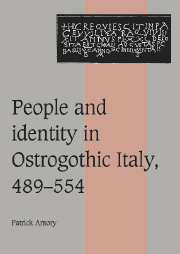Book contents
- Frontmatter
- Contents
- Preface
- List of rulers
- Terminology and vocabulary
- List of abbreviations
- Map of Ostrogothic Italy
- Introduction: Studying the barbarians in late antiquity
- 1 Ethnicity, ethnography and community in the fifth and sixth centuries
- 2 The Ravenna government and ethnographic ideology: from civilitas to bellicositas
- 3 Individual reactions to ideology I: names, language and profession
- 4 Complementary and competing ideals of community: Italy and the Roman Empire
- 5 Individual reactions to ideology II: soldiers, civilians and political allegiance
- 6 Catholic communities and Christian Empire
- 7 Individual reactions to ideology III: Catholics and Arians
- 8 The origin of the Goths and Balkan military culture
- Conclusion
- Appendix 1 The inquiry into Gundila's property: a translation and chronology
- Appendix 2 The Germanic culture construct
- Appendix 3 Archeological and toponymic research on Ostrogothic Italy
- Appendix 4 Dress, hairstyle and military customs
- Prosopographical Appendix: A prosopography of Goths in Italy, 489–554
- Bibliography
- Index
- Cambridge Studies in Medieval Life and Thought Fourth Series
Prosopographical Appendix: A prosopography of Goths in Italy, 489–554
Published online by Cambridge University Press: 03 December 2009
- Frontmatter
- Contents
- Preface
- List of rulers
- Terminology and vocabulary
- List of abbreviations
- Map of Ostrogothic Italy
- Introduction: Studying the barbarians in late antiquity
- 1 Ethnicity, ethnography and community in the fifth and sixth centuries
- 2 The Ravenna government and ethnographic ideology: from civilitas to bellicositas
- 3 Individual reactions to ideology I: names, language and profession
- 4 Complementary and competing ideals of community: Italy and the Roman Empire
- 5 Individual reactions to ideology II: soldiers, civilians and political allegiance
- 6 Catholic communities and Christian Empire
- 7 Individual reactions to ideology III: Catholics and Arians
- 8 The origin of the Goths and Balkan military culture
- Conclusion
- Appendix 1 The inquiry into Gundila's property: a translation and chronology
- Appendix 2 The Germanic culture construct
- Appendix 3 Archeological and toponymic research on Ostrogothic Italy
- Appendix 4 Dress, hairstyle and military customs
- Prosopographical Appendix: A prosopography of Goths in Italy, 489–554
- Bibliography
- Index
- Cambridge Studies in Medieval Life and Thought Fourth Series
Summary
METHOD AND PURPOSE
Few individuals from sixth-century Italy are called “Goth” or “Roman” outside the works of Procopius. In order to understand the force of the label “Goth,” and by implication its occasional antithesis “Roman,” this prosopography assembles every attested individual in Italy from the period of Ostrogothic rule who could have been classified as a “Goth” according to the various contemporary criteria identifying the group: a Germanic personal name (or one in the family), military service, Arian belief, membership in the Arian clergy, and knowledge of the Gothic language, and anyone related to people showing these characteristics (since classical ethnography assumes family ties among the people that it describes). The subsequent set of tables in Part III strains out these criteria to illustrate the extent to which they match up among different groups in Italian society at different dates.
This “prosopography of identity” thus serves a different function from traditional prosopography. It examines the ways in which individuals are not connected as much as the ways in which they are connected, within the limits of a community as defined by contemporary sources. Different groups inside and outside Italian society defined Goths in various ways: as Arian believers and clergymen, as soldiers, as saiones and military comites, as speakers of a Germanic language, and as the enemies of Justinian's armies in Italy. To what extent do these criteria coincide in an attested individual?
- Type
- Chapter
- Information
- People and Identity in Ostrogothic Italy, 489–554 , pp. 348 - 486Publisher: Cambridge University PressPrint publication year: 1997



